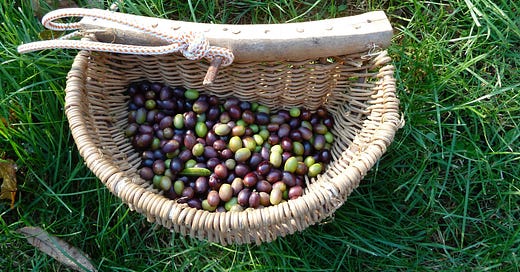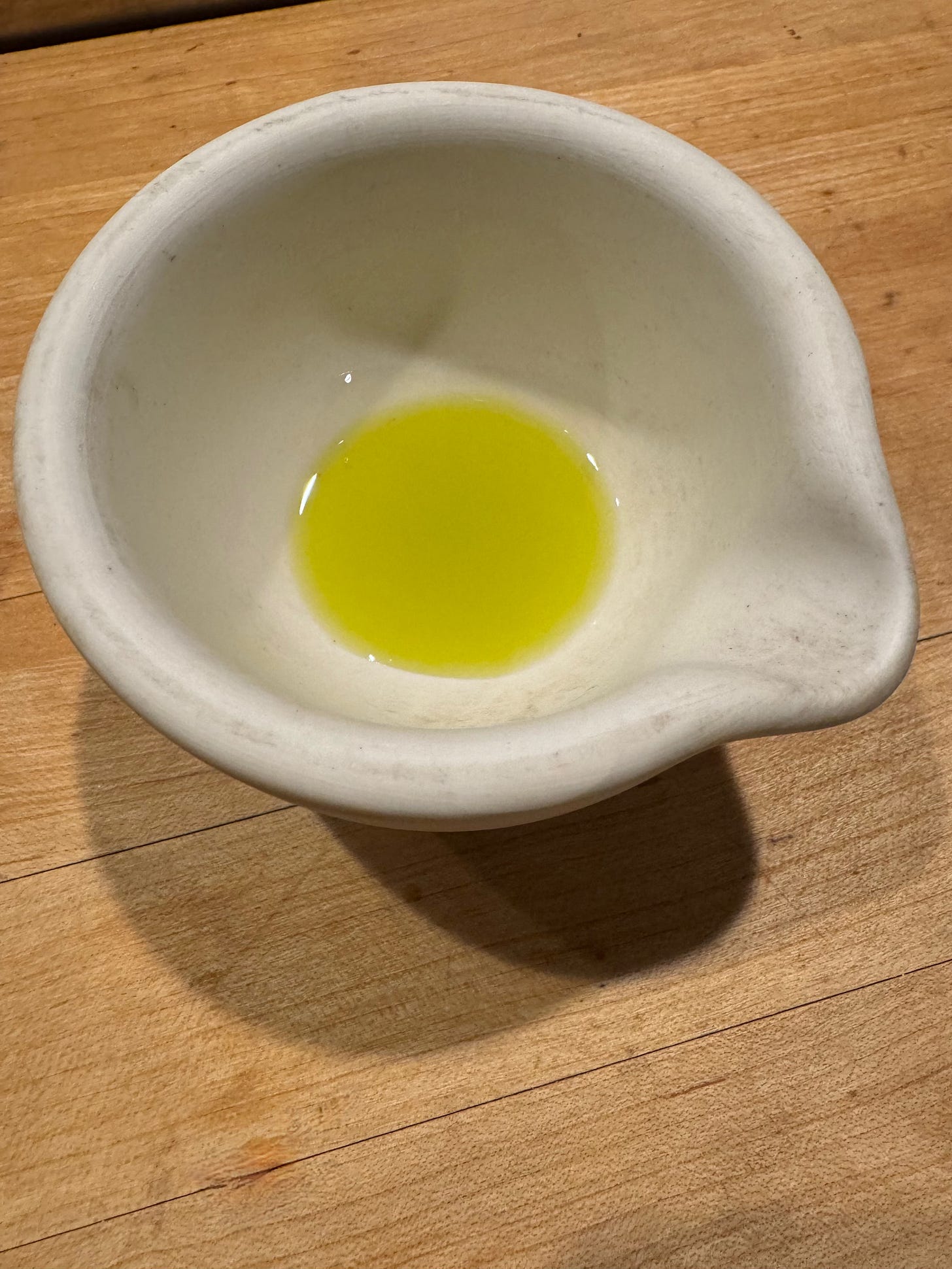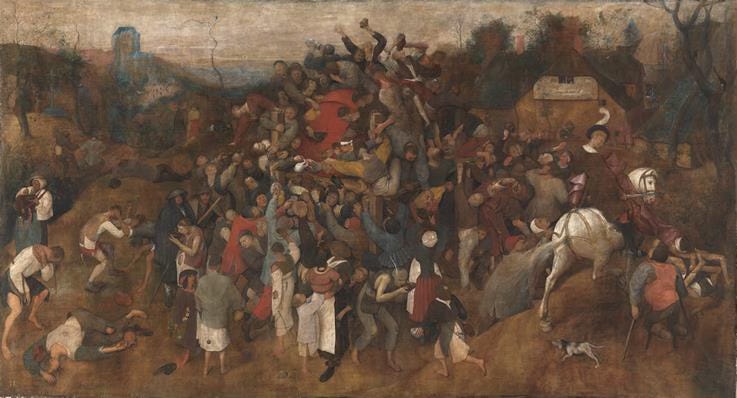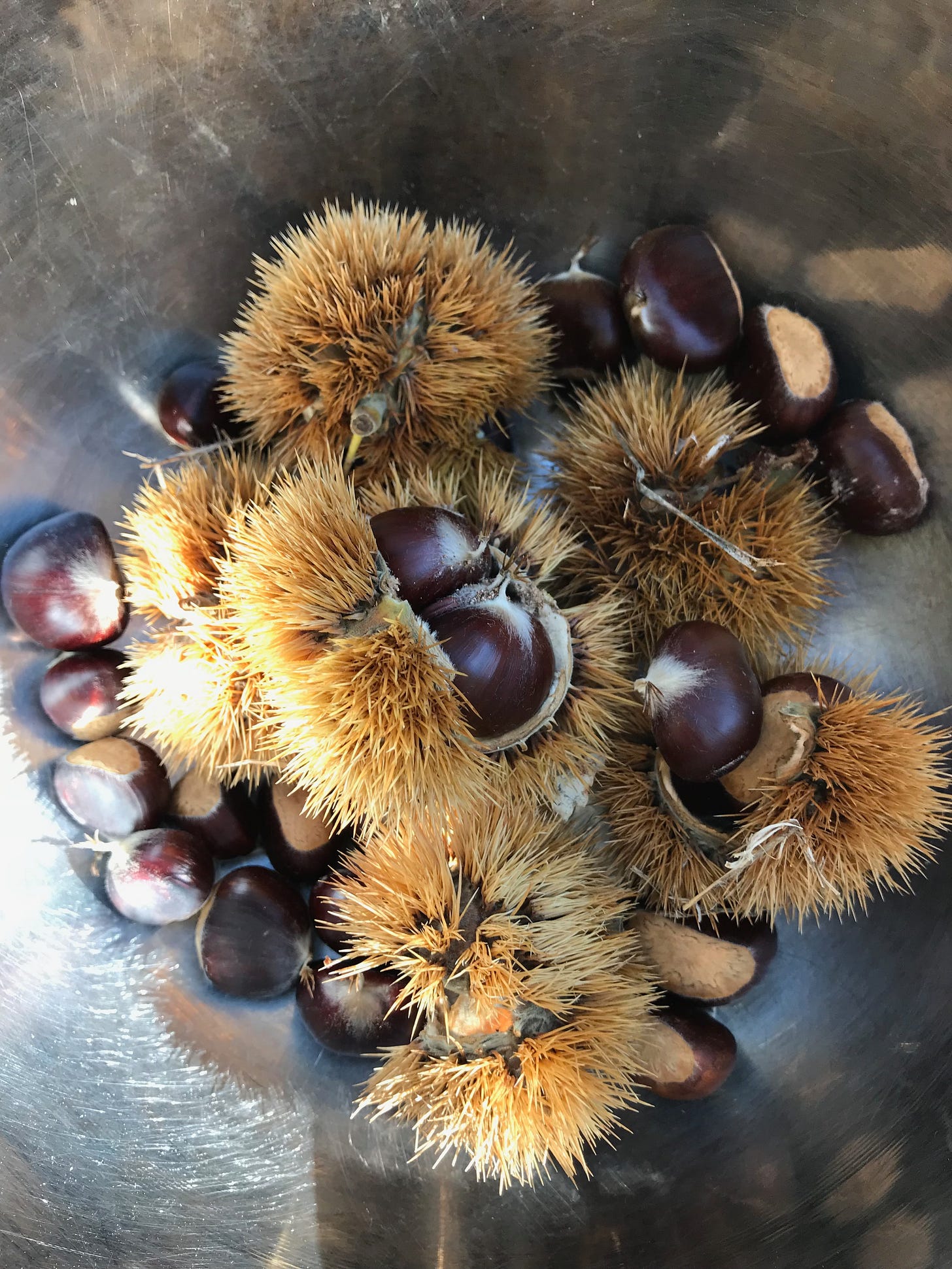Seasonal thoughts re: Oil, wine, pumpkins & rice, plus a harangue about tipping
and a simple seasonal risotto
Please just tap that little heart up there on the left to show you like this—it means a lot!
Last week, the new oil arrived from our Tuscan mini-farm, brought by Sara who had once again supervised its production. Harvesting olives and making our oil means a period of intensely hard and focused work carried out by various teams, including friends, friends of friends, neighbors, casual drop-ins, and some of the more enthusiastic staff from Sara’s restaurant who went to Cortona for the event.
And the oil? A much lower resa (yield) than last year, owing to early autumn rains that filled the olives with water, according to our Mr. Landi at his frantoio (olive mill) on the road to Arezzo. As a result, a softer, sweeter flavor, still with that distinctive Tuscan pizzica in the back of the throat but what I can only call lush or perhaps luscious in texture. Altogether pleasing and altogether distinctive, everything that the best hand-crafted oil should be.
And speaking of best, Sara was thrilled to discover that our last year’s oil, the 2023 harvest, was a prize-winner. In a competition among all the local oil makers, we won for excellence in the fruttato (fruity) category. I say “we” because I take full credit for having the foresight to plant 150 olive trees some 25 years ago when everyone, and I mean Every. One. Of. Our. Neighbors cautioned against it.
Has it been worth it, all those years of money spent, time and labor exerted, the agony of watching the summer skies when hail is threatening, the snowy peaks when an icy frost is predicted? Yes and no. About the weather, as most farmers know there’s not much to be done about it and in any case olives, at least in Central Italy, have proven themselves to be uniquely capable of recovering from the most malign events, like the terrible time in January 1985 when a devastating period of very low temperatures threatened to kill off all the trees and destroy olive cultivation in Tuscany for good. But now, 40 years later, most of those trees that looked dead on arrival have recovered and regained healthy production. (That noise you hear is me tapping wood as I make that statement.) If you can take the long view, you will be a better farmer. Or, as my neighbors say, you plant a vineyard for your children, an olive grove for your grandchildren—that’s what taking the long view means.
So has it been worth it? Well, indeed, yes and no. Probably if I sat down and made a calculation of every expenditure over the years, and not counting labor costs which are more or less “free,” I would find that we’ve spent more than we’ve saved, given the fact that we haven’t had to buy olive oil for our own uses for many years. On the other hand, I’m reminded of Burton Anderson’s statement in Treasures of the Italian Table (1995), that the most expensive olive oil he’s ever tasted (and probably the best, too) is the stuff he makes himself. I can go along with that.
And still, there is pleasure to be gained from the very experience, from knowing more than most people (even many self-styled experts) what makes good extra-virgin olive oil and how to recognize it for its excellence.
And even more important, from knowing that we’re helping to maintain, sustain, and evolve a tradition that goes back to the very founding of human civilization in this part of the world. When so much of our food, no matter where we are in the world, is produced by industrial processes--planted, cultivated, harvested, and processed by machinery, even machinery run to an extent by humans--the taste and texture of our own olive oil, the sense of connection between the food we put in our bodies and the people and places and processes that have gone into it—that’s a precious thing.
San Martino: Ogni mosto diventa vino!
November 11, Armistice Day, Veterans Day in the US, Remembrance Day in the UK, recognizes the overwhelming sacrifices on both sides of World War I, the opening round of what will surely go down in history as the century of total global warfare.
But it’s also the feast of St. Martin, the fourth-century bishop of Tours, remembered for his own sacrifice when, spying a cold and naked beggar, he took up his sword, sliced his cloak in half, and therewith clothed the wretch. Years ago, when I lived in Madrid during the Fascist years, fashionable gentlemen wore in winter superbly elegant cloaks or capes, many of them from the historic bespoke cape maker Seseña, which still occupies its original setting in calle de la Cruz, near Madrid’s Plaza Santa Ana. Those capes were dramatic black sweeps of heavy wool, often lined with maroon or deep green velours paneling that offset the drama of the cape when swirled over the gentleman’s shoulder. And the feast day of San Martín was the day, appropriately, that they all came out. It was a splendid vision, hundreds, maybe thousands, of old-fashioned gents, their cape-clad elegance thronging the streets of the city, but, as far as I can tell, sad to say, it doesn’t happen any more.
In fact, the feast day of San Martín (San Martino in Italy) is barely acknowledged at all nowadays, although it was once an important calendar marker of the start of winter, even if the solstice was (and is!) still six weeks away. Except in wineries where San Martino is anxiously anticipated. Ogni mosto diventa vino –“every must becomes wine”—throughout Italy’s wine country, it signifies the moment when grapes and their juice, the mosto, will finish seething and bubbling with fermentation as sugars in the grapes are converted to alcohol. What emerges now is new wine, vino novello, vin nouveau, truly wine, albeit youthful still, sharp, and acid. It’s a day celebrated throughout the wine-making world, or at least the part of that world that lives in the Mediterranean, with a taste of the season’s wine and a lot of assessment about the next stages.
In fact, things can get a little out of hand, as the Elder Breughel observed in one of the Prado Museum’s fabulous collection of his works. I don’t think you can see this very well, unfortunately, but next time you’re in Madrid, seek it out for the stunning and hilarious display of the effects of new wine on a tumultuous crowd.
Chestnuts, ripe now and ready to harvest, are also tied to the feast. If we only had chestnuts in the United States, if our chestnut trees hadn’t all died of a miserable blight, we too might gather around the hearth of a November evening and roast chestnuts to go with the new wine. It’s not a bad combination, because the meaty sweetness of roasted chestnuts are a fine complement to the sharpness of new wine. If you have a fireplace, if you can find fresh chestnuts, if you have access to new wine—try it some blustery evening, but be prepared to have a store of stories to tell as well.
This is what Tuscans call la veglia (the vigil), and it’s a cultural tradition that’s as old as new oil, as old as new wine, as old as a fireplace and a family that gathers together to fend off the cold and share the warmth of connection—something that feels very much needed right now.
Tipping: a harangue
I do it and if you’re an American, I expect you do it too—tip, here, there, everywhere, wait staff, taxi drivers, hair salons, carry-out counters, delis, wherever you pay with a credit card, and many of us do almost all of our transactions with a credit card these days, up pops that menu at the end, asking 15%? 20%? 30%?
And we tap on a tip percentage and go about our business, having added x% to the cost of whatever we’ve purchased.
I hate it! I think it’s demeaning, condescending, patronizing, and damned unfair. And yet I do it, locked into this miserable system.
Last week I went to my usual hairdresser, a genial person I’ve relied on for expert haircuts for several years. He not only owns the salon, he also handles all the operation. He washes my hair, cuts it, styles it, and then hands me the bill. “Dan,” I said, “I’m not adding a tip.” He looked startled. Had he done something wrong? “Look,” I explained, “you own this establishment, you set the prices. If you think you need 20% more than the bill you’ve given me, then, for heaven’s sweet sake, man, raise your prices! But don’t expect me to guess what the price ought to be!” When I left, I said, “Next time, if you want 20% more, just charge me that.”
I’m still not sure he understood.
After that, I went on to a favorite bakery patisserie where I went through the same routine. “If you want more money for these gorgeous pastries,” I said, “just charge more.” “Oh, it’s not for me,” the owner replied, “it’s for them” and she gestured to a window behind which I could see two strapping guys rolling out delicate laminated doughs. The suggestion, clearly, was that they were being deliberately underpaid by the owner of the establishment and were, like wait staff in a restaurant, relying on tips to make up the difference.
I don’t think that’s true. I think, if it is true, it’s illegal.
So again, I didn’t tip.
I may be followed to my grave by the lowering looks of all the people I’ve decided on my own not to tip but if we don’t stop this, we’re going to end up adding 20% or more to every single transaction we undertake. The Triple A guy who changes my tire? The grocery store clerk who bags my purchases? The gas station attendant who stands by and watches while I fill the tank myself? The exercise coach at the gym? The woman who mows my lawn and dead heads my roses? The pastor at my church after he gives a fine sermon? (I’m joking—I don’t go to church.)
I continue to tip wait staff in restaurants—I mean, proper sit-down restaurants where the food is brought to the table—but I do that only because I know that wait staff is seriously--and legally--underpaid and tips are expected to make up for that. This is the way the government sees it and this is why the government taxes those tips, pace both Kamala Harris and Donald Trump. It is all legal and above board in most establishments: oftentimes tips are pooled, recorded in account books, and divided among the dining room staff. (That’s another problem: arguably the kitchen, from executive chef to dish washer, is equally involved in the production of your perfect meal, but the kitchen is paid a living wage and does not profit from customers’ tips.)
So why don’t more restaurateurs switch to a no-tip policy? For a very simple reason: Paying the wait staff a living wage means raising the price of each dish to cover the increased cost and customers will not do it. They will walk away and go to the establishment down the street with a menu that’s 20% cheaper. It has been tried over and over again, and in the end, the restaurant goes back to tipping rather than lose their clientele. That very same clientele that thinks nothing of adding 20% to the bottom of the tab will not pay outright 20% more for an individual dish or a meal.
And so we are locked into this miserable system, at least until all the restaurants in a given area decide together to move away from tips. And that will be a very long time coming.
I can’t speak for the rest of Europe, but in Italy tipping in restaurants is not at all customary. I learned early on that you tip only if you have a large party, six or more, which requires greater effort by the wait staff, and even then the tip is a small proportion (5% perhaps) of the total tab. On the other hand, in Italy one does tip three times a year—at Easter, Ferragosto, and Christmas, and then you tip just about everyone in range, from the mailman to the garbage collector to the concierge of your building to the, well, I can’t think of the rest but they are legion. So it might be just as insidious as our system but at least it’s not something you have to face up to every day.
How do you feel about this practice? If we consumers were to band together and demand an end to it, something might happen. On the other hand, I suppose, given the vagaries of the American electorate, something very well might not happen at all.
The remainder of this post is for paying subscribers. If you’d like to gain access, please join the group.
Keep reading with a 7-day free trial
Subscribe to On the Kitchen Porch to keep reading this post and get 7 days of free access to the full post archives.








